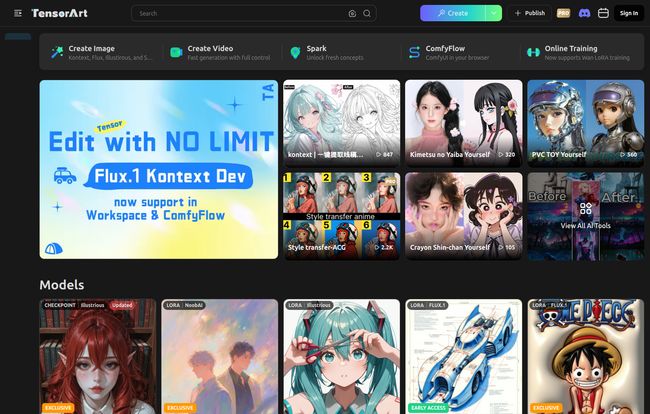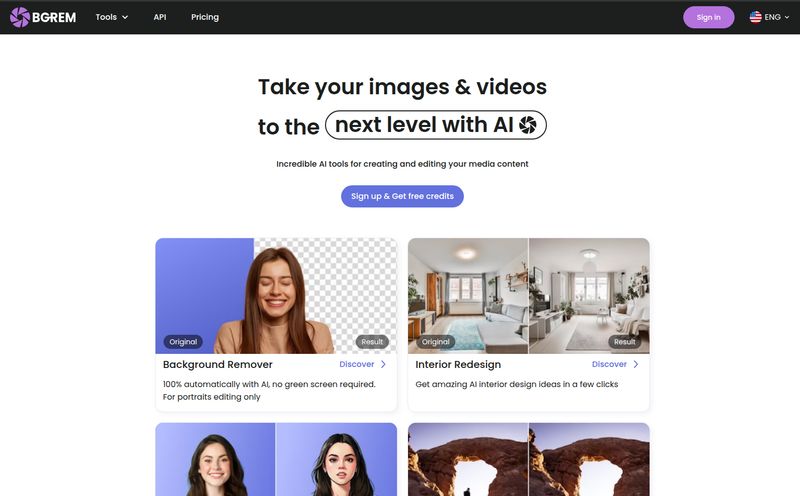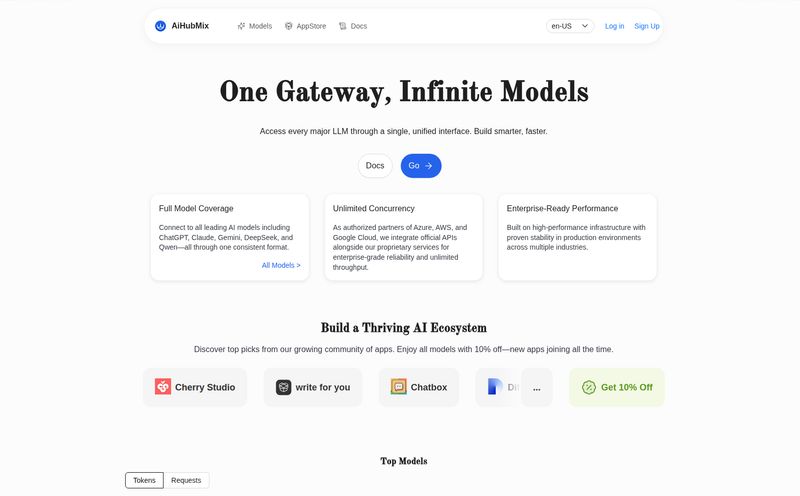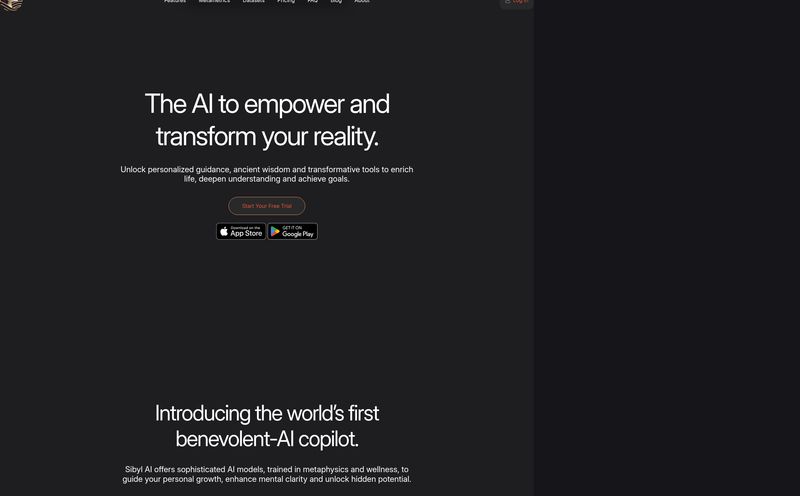I’ve spent more money on AI image generator subscriptions than I care to admit. Between my Midjourney habit and dabbling with DALL-E 3 through various paid services, my credit card has seen some things. It’s the price we pay for staying on the bleeding edge of content creation, right? Or so I thought.
Then, I stumbled upon Tensor.Art. And my first thought was, “Okay, what’s the catch?” A platform that offers not just free AI image generation but also model hosting, advanced workflows, and a library of community models that could make a grown SEO weep with joy? It sounded too good to be true. But after spending a good few weeks tinkering, creating, and generally getting lost in its digital rabbit holes, I'm here to tell you… it’s the real deal.
So, What is Tensor.Art, Really?
Calling Tensor.Art just an “AI art generator” is like calling a Swiss Army knife just a “knife.” It’s technically true, but you’re missing the point entirely. Think of it less as a single tool and more as a massive, open-access workshop or a public library for AI models. It’s built on the foundations of Stable Diffusion, but it’s not just one flavor. It's a platform where creators can upload, share, and use a dizzying array of models, LoRAs, and Checkpoints.
For those of you who aren't deep in the AI art weeds, a Checkpoint is like the core brain of the AI model, defining its fundamental style. A LoRA (Low-Rank Adaptation) is a smaller file you can apply on top of that brain to teach it a very specific style, character, or concept without retraining the whole thing. Tensor.Art is basically a playground where you can mix and match all these components. For free.
Did I mention it’s free?

Visit Tensor.Art
First Impressions: A Candy Store for AI Nerds
Landing on the Tensor.Art homepage feels a little like walking into a bustling digital bazaar. You're immediately greeted with a gallery of stunning images, from hyper-realistic portraits to vibrant anime scenes and wild sci-fi concepts. The main sections are laid out up top: Create Image, Create Video, Spark, and the one that made my inner geek light up, ComfyFlow.
The sheer volume of user-created models is the first thing that hits you. Each one has a thumbnail, a name, and stats on likes and usage. It’s a living, breathing community, not some sterile corporate tool. You can see what’s popular, what’s new, and what’s “Exclusive.” It’s a far cry from the simple prompt box most of us are used to. It's an invitation to explore, not just generate.
The Crown Jewel: The Massive Model Library
This is where Tensor.Art truly shines and pulls away from the pack. While other services give you their one or two finely tuned house models, Tensor.Art gives you the keys to the entire kingdom. You can browse and use hundreds of models tailored for specific looks.
LoRAs, Checkpoints, and Why You Should Care
Look, I get it, the terminology can be a bit much. But stick with me. Have you ever tried to get a consistent character or a specific artistic style (like, say, 1950s pulp sci-fi book covers) out of a generic AI model? It can be a nightmare of prompt engineering. With Tensor.Art, you can just find a LoRA someone has already trained for that exact purpose, click to use it, and you're 90% of the way there. It’s a shortcut to creative genius, and I’m all for it. You can find LoRAs for character designs, clothing styles, artistic mediums, you name it.
So Many Styles, So Little Time
The platform helpfully categorizes models into sections like Real World, Anime, Illustration, and even Advertising Design. Want to generate photorealistic images? Grab a model like “Clarity” or “RealVisXL.” Feeling more of an anime vibe? “AniCortex-XL” has you covered. This ability to pick the right tool for the job, rather than forcing one tool to do everything, is a fundamental shift in how we can approach AI art creation. It feels more intentional, more artistic.
Unleashing Your Inner Mad Scientist with ComfyUI
Okay, let's talk about the big one: ComfyUI. On the Tensor.Art dashboard, you'll see a section for "Workflows" and the "ComfyFlow" tool. This is not for the faint of heart, but it is incredibly powerful. ComfyUI is a node-based interface for Stable Diffusion. Instead of a simple text prompt, you get a visual flowchart where you can connect different blocks (nodes) to build your own image generation process from the ground up.
It’s the difference between using a microwave (just push a button) and cooking a gourmet meal from scratch. You can control every single step: load a base model here, apply a LoRA here, input a positive prompt, a negative prompt, upscale the image using a specific method, and so on. Intimidating? A little. But the level of control is unparalleled. For anyone who’s ever felt limited by a simple text box, this is your new favorite toy. And Tensor.Art lets you run these complex workflows in the cloud, for free, without melting your own GPU.
The Not-So-Shiny Bits (A Balanced View)
No platform is perfect, not even my new favorite free one. It’s only fair to point out the trade-offs.
First, the learning curve is real. If you just want to type “a cat astronaut” and get a picture, the sheer number of options and models might feel like overkill. To get the most out of it, you need to be willing to learn what a LoRA is and why you might pick one Checkpoint over another. Secondly, since it's a free service, generation speeds can sometimes vary. I’ve had images pop out in seconds, and other times I’ve been in a queue for a minute or two. A small price to pay for… well, not paying a price.
Finally, there's the content aspect. Like any powerful tool, it can be used to create just about anything, including stuff that might be NSFW or problematic. Tensor.Art puts the responsibility on the user, which is standard practice but something to be aware of.
Who Is Tensor.Art Really For?
After all my testing, I think Tensor.Art is perfect for a few types of people:
- The Curious Hobbyist: Someone who’s played with other AI tools but wants to go deeper without a financial commitment.
- The Stable Diffusion Veteran: Anyone who loves running Stable Diffusion locally but hates the strain on their own hardware. This gives you a powerful cloud-based setup for free.
- The Aspiring AI Artist: If you want to develop a unique style, learning to mix and match models and LoRAs here is an incredible education.
- The Content Creator on a Budget: If you need a high volume of diverse images for blog posts, social media, or mockups, the cost (zero) is unbeatable.
My Final Takeaway: It’s a Game-Changer
Tensor.Art feels like a democratizing force in the AI art space. It takes the power of complex, open-source models and makes them accessible to anyone with an internet connection. It's a platform built on community, sharing, and experimentation. While paid services offer a more polished, streamlined experience, Tensor.Art offers something more exciting: a boundless playground. It’s a little messy, a little wild, and absolutely brilliant. If you have any interest in AI image generation, you owe it to yourself to go sign up and start playing. You might be surprised by what you create.
Frequently Asked Questions about Tensor.Art
- 1. Is Tensor.Art really free to use?
- Yes, as of my latest check, the core service of generating images and using the vast library of models is completely free. They offer a certain number of daily credits that generously refresh, allowing for substantial daily use without paying a dime.
- 2. Can I upload and use my own models?
- Absolutely. One of the platform's biggest strengths is its model hosting capability. You can upload your own Checkpoints, LoRAs, and other model types to use in your private workspace or share with the community.
- 3. Is Tensor.Art good for beginners?
- It can be. While its advanced features like ComfyUI are aimed at power users, a beginner can easily stick to the basic text-to-image mode. You can pick a popular, highly-rated model from the main page and start generating images right away without touching the complex stuff. It has a lower barrier to entry than running Stable Diffusion on your own computer.
- 4. What's the main difference between Tensor.Art and Midjourney?
- The main differences are cost and customisation. Midjourney is a paid, proprietary model with a very distinct, polished aesthetic. It’s simpler to use. Tensor.Art is a free platform that gives you access to hundreds of different open-source models (based on Stable Diffusion), offering far more style variety and granular control, especially for users willing to learn its advanced tools.
- 5. Do I need a powerful computer to use Tensor.Art?
- Not at all! That's another major benefit. Because everything runs in the cloud on their servers, you can use Tensor.Art on almost any computer or device with a web browser. It does all the heavy lifting for you.
- 6. What is ComfyFlow on Tensor.Art?
- ComfyFlow is Tensor.Art's name for its integrated ComfyUI workspace. It's a powerful, node-based interface that allows you to build custom image generation workflows for maximum control over the creative process.
Reference and Sources
- Tensor.Art Official Website
- ComfyUI GitHub Repository - For those who want to understand the underlying node-based engine.



